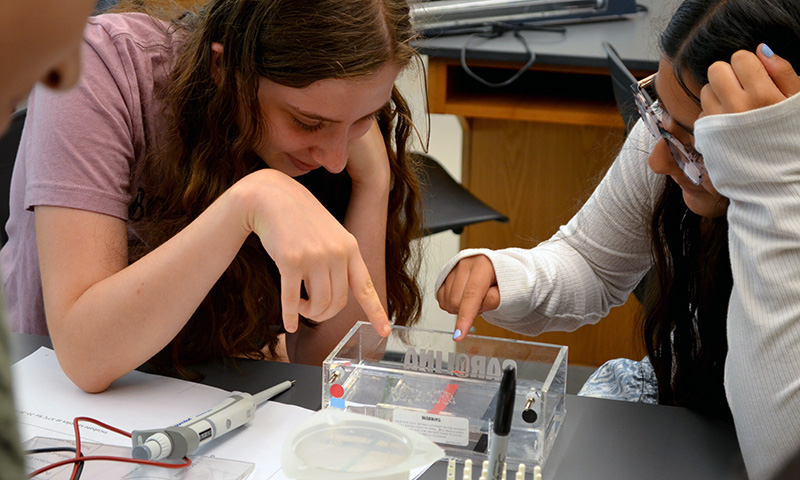Genome Science
Analyze the genetic complement of organisms

Genome Science is offered in-person at DNALC locations and virtually on-demand.
In-Person Genome Science
The term genome was coined in 1920 by the German botanist Hans Winkler. A combination of the words gene and chromosome, a genome is the set of genes located on one or more chromosomes that defines a living organism. The concept of a genome has been expanded to mean the entire sequence of DNA nucleotides or "letters" (ATGC) that compose the genetic information within an organism's set of chromosomes, or all of its genes. Complete genome sequences are now available for humans and many plants and animals. With this information in hand, the next step is for scientists to understand the physiological functions of the thousands of genes for which little is known beyond their sequences.
In this camp, participants will use Nobel Prize-winning technologies to analyze the genetic complement of several organisms. Lab work will include:
- using PCR (polymerase chain reaction) and DNA sequencing to explore variations in the human genome—and then bioinformatics to explore human origins and migrations with the data;
- using PCR to explore the relationship between genotype and phenotype for a taste receptor that affects the ability to taste the bitter chemical phenylthiocarbamide (PTC);
- using PCR to identify genetically modified plants and food products; and
- using online bioinformatic tools for genomic analysis and gene mapping.
Details:
- Grades: entering grade 11–12 and have taken DNA Science or AP Biology (documentation from school required)
- $700 per student
- Monday to Thursday 9:30 a.m.–4:00 p.m., Friday 9:30 a.m.–2:00 p.m.
- Available at:
On-Demand Genome Science
The term genome was coined in 1920 by German botanist Hans Winkler. A combination of the words gene and chromosome, a genome is the set of genes located on one or more chromosomes that defines a living organism. The concept of a genome has been expanded to mean the entire sequence of DNA nucleotides or "letters" (ATGC) that compose the genetic information within an organism's set of chromosomes, or all of its genes. Complete genome sequences are now available for humans and many plants and animals. With this information in hand, the next step is for scientists to understand the physiological functions of the thousands of genes for which little is known beyond their sequences. In this online camp, participants will use new at-home adaptations of Nobel Prize-winning technologies, as well as computer-based techniques to analyze genetic components of humans and plants. Students will:
- isolate their own DNA to explore genetic polymorphisms and learn about human origins and migration;
- perform isothermal PCR reactions with their own DNA to identify the presence or absence of a transposable element that can be used to understand allele frequencies and population genetics;
- isolate DNA from common foods for a PCR test that will indicate genetic modifications; and
- use online bioinformatics tools to compare DNA sequences and mine information from DNA databases.
Details:
- Grades: entering grade 11–12 and have taken DNA Science or AP Biology (documentation from school required)
- Students are required to drop off or overnight ship (USPS/FedEx/UPS) their DNA samples to the Dolan DNALC in Cold Spring Harbor following completion of the Day 1 video of the camp. The cost of shipping is to be covered by the student and their family.
- $420 On-Demand
- Available:


